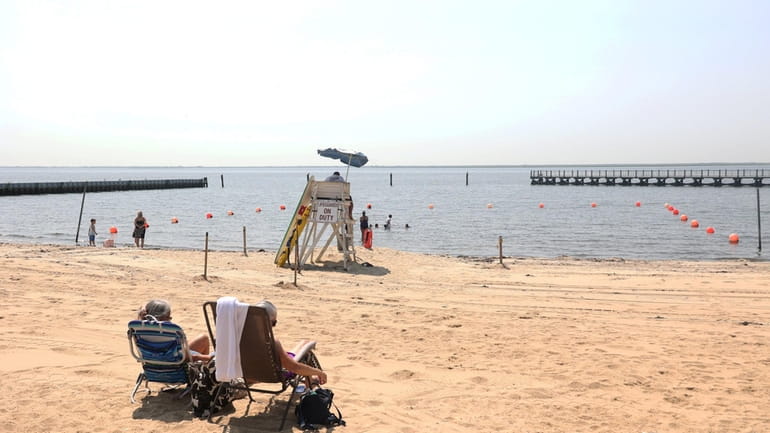4 Long Island beaches among those most often testing positive in New York for fecal contamination, report says

Tanner Park Beach in Copiague on Wednesday. It had potentially unsafe levels of fecal indicator bacteria on 24 of 50 test days last year. Credit: James Carbone
Four Long Island beaches were among the 10 in New York State that in 2022 most frequently tested positive for bacteria associated with potentially harmful fecal contamination, according to a recent report.
In Suffolk County, Babylon’s Tanner Park had potentially unsafe levels on 48% of testing days; Islip’s Benjamin’s Beach and Bayport Beach reached those levels on 45% and 28% of testing days. In Nassau, Hempstead’s Hewlett Point Beach reached potentially unsafe levels on 28% of testing days.
The number of test days ranged from 1, at Fishers Island Country Club, to 57 at Hewlett Point.
Bret Bennington, chair of Hofstra University’s Department of Geology, Environment, and Sustainability, said the report highlighted that “what people are doing on the land … gets carried into the water.” And, he said, in some problem areas after heavy rain, people might want to “stay away from the beaches for a couple of days.”
WHAT TO KNOW
- Four Long Island beaches were among those in New York where water tests most frequently showed potentially unsafe levels of fecal contamination, according to a recent report by a Colorado-based environmental organization.
- The report, which covers states with ocean and Great Lakes beaches, calls for more investment in sewers and wetlands restoration, among other steps.
- State and county officials said that beaches are safe on most days, but residents can check beach status and water quality at New York State Department of Health (healthinspections.us)
Beaches exceeded federal standards
The study by Environment America, a Colorado-based advocacy group, used data uploaded to a federal water quality portal maintained by the Environmental Protection Agency. Beaches were “potentially unsafe” if water samples showed bacteria levels exceeded a federal recreational water quality standard for safety.
For saltwater, the study used measures of enterococcus, a bacteria that is not harmful to humans but may indicate pathogens that cause gastrointestinal illness.
“All too often, on far too many beaches, pathogens in the water posed a risk to swimmers’ health,” said John Rumpler, clean water program director for Environment America and one of the report’s authors. On Long Island, he said, contamination sources include stormwater runoff and septic leakage.
The report recommends increasing investment in infrastructure that would better contain these sources of bacteria, preventing manure pollution at factory farms, protecting wetlands and expanding beach testing.
In New York last year, public health officials tested 344 beaches, according to the report. At 198 beaches, tests showed potentially unsafe levels of fecal indicator bacteria on at least one day, and at 41 beaches, tests showed potentially unsafe levels on at least a quarter of all testing days.
In Nassau County, 26 beaches tested potentially unsafe at least one day, and in Suffolk 102 beaches tested potentially unsafe at least one day, according to data Rumpler provided.
Nassau and Suffolk county health department representatives said they routinely monitor water quality at Long Island’s roughly 250 permitted beaches, issuing advisories and closing beaches when needed. Last year, Nassau had 11 closures and Suffolk had 76. While Environment America’s report cited an estimated 57 million annual cases nationally of illness from swimming in oceans, lakes, rivers and ponds, the representatives said they knew of no cases on Long Island.
“While on most days, Suffolk County's beaches are pollution free and provide a safe and healthy recreational environment for the public, a few of our beaches are located in areas that are heavily influenced by stormwater runoff from the surrounding watersheds or adjacent tributaries, and, because of their location in an enclosed embayment, experience limited tidal flushing,” said Marykate Guilfoyle, a Suffolk spokeswoman, in an email.
Tidal flushing key to safety
Some of Long Island’s most visited beaches were also its cleanest, including Jones Beach, where measurements never reached potentially unsafe levels, and Robert Moses, where they did just once. Those beaches sit directly on the Atlantic Ocean, unlike the four beaches named in the report, which are on South Shore bays that enjoy the protection of Long Island’s barrier beaches but have lower tidal flushing.
Babylon Town waterways management supervisor Brian Zitani said that Tanner Park, in Copiague on the Great South Bay, was partly a victim of geography: located on a relatively narrow stretch of the bay, far from inlets, in a densely populated part of Long Island where most of the salt marsh that might once have filtered water has been developed.
The biggest contaminant source: “all that dog poop, animal waste, anything that’s on lawns and streets goes into the drains and washes into the bay” when it rains. Septic systems, a groundwater concern across much of the county, were replaced by a public sewer system in that part of the town decades ago.
“The sad reality is, it is fairly often” that public health officials order Tanner closed because of bacterial readings, Zitani said, but the town’s options are limited. Engineering solutions like drain filters are expensive and impractical; rebuilding the shoreline and seeding natural filters like mollusks is difficult because most of the shoreline is privately owned.
